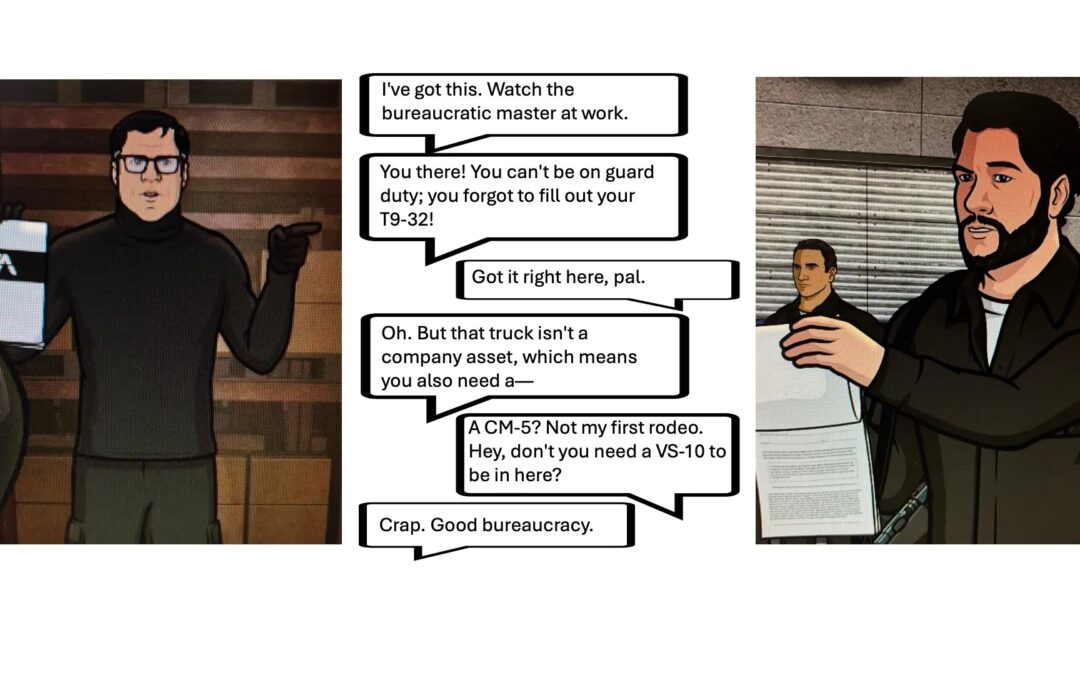There is an episode of the TV show “Archer” that always crosses my mind when I think of bureaucracy. In this scene (season 12 episode 7), the character Cyril Figgis is trying to infiltrate an enemy spy agency. He tells his partner he will get them past the guard, and the following conversation ensues:
Cyril: You there! You can’t be on guard duty; you forgot to fill out your T9-32!
Guard: Got it right here, pal.
Cyril: Oh. But that truck isn’t a company asset, which means you also need a—
Guard: A CM-5? Not my first rodeo. (Holds up form) Hey, don’t you need a VS-10 to be in here?
Cyril: Crap. Good bureaucracy.
(Side note and warning: Archer is an adult show that is very inappropriate for work audiences!)
I always think of this scene because there is such a thing as good bureaucracy! Paperwork is intended to guide people, accomplish work tasks, and prevent them from doing things they shouldn’t be doing. In the case of my example, good bureaucracy prevented an enemy spy agent from easily infiltrating the warehouse. While we aren’t all defending warehouses from spies, good bureaucracy can help with supply chain policy and procedure compliance. That being said, Warren Buffett is famous for calling bureaucracy one of “the ABCs of business decay, which are arrogance, bureaucracy, and complacency.” Especially having spent time in a utility business, I’ve seen my share of Bureaucracy Gone Wild. Some bureaucracy reduces risk. Too much bureaucracy dramatically slows down a business. Here are some things to think about with respect to bureaucracy in your business, specifically in your supply chain.
Approvals
Approvals are very common in supply chain processes, as approvals and spending company money go hand-in-hand. Especially on the scale of most business spend, it’s important to ensure company money goes to the right suppliers for the right goods and services, in alignment with the company’s approach to cost, speed, and quality. I’ve seen approvals in the following places in the supply chain:
- After the requisition is placed
- After the PO is created (before it is sent to the supplier)
- Before a bid is published
- After a winning bidder is selected
- Before a contract is signed
I’ve seen others in between these steps, but these are the most common. The problem is that these approvals very quickly become too numerous and then become counterproductive. Add on each of these approvals going through multiple managers, directors, and vice presidents, and you have a mess.
If everyone is accountable, no one is. For example, if the buyer, procurement manager, and procurement director are all approving a bid, they all expect the other two to spend time scrutinizing the bid to be published. With three approvals, you’re much more likely to have everyone in the chain click “approve” without really reading the document simply to get it off their plates. This issue increases tenfold for each approval added and if the approvals cross teams (such as both the technical team and the supply chain team).
Consider your approvals carefully, and make sure you have just enough to double check actions without everyone assuming “someone else” is looking more closely than they are.
Requisitions or Requests to Purchase
The request to purchase from a business unit to the supply chain team is often the biggest pain point in an organization. It is so easy for a supply chain or procurement team to require one more step, one more piece of information, or one more business approval until the process is so bloated everyone is looking for workarounds. You know you have this problem if your purchasing card spend is out of control, if you’re constantly catching internal stakeholders not following the process, or if team members are using home-grown applications (or Excel) to manage all of their purchasing instead of the ERP system.
If you have an overly-bureaucratic process for purchasing items, try these actions.
- Have your buyers spend some time going through the process to purchase items. Either have them sit with their customers for a day and enter requisitions/requests to purchase or otherwise put them “in the customer’s chair” for a while. This is especially effective if your buyers have a bit of Lean or Six Sigma training or are the type of people who get very annoyed by inefficient processes. It’s also a great place to put a Technical Guru or Newbie for a little while.
- Set a continuous improvement team to map every click, every instance of typing, and every bit of institutional knowledge needed to purchase something. Put it in a process map; post-it notes on a wall can go a long way toward being able to see and eliminate waste. Question every single step and ask: what can be removed entirely? What can the system automate (i.e. entering the same info every single time, like a tax code)? What entry info is truly needed?
- Consider allowing purchasing card purchases for your tail spend. Small, low-risk transactions are what p-cards do best, and they don’t have to be the enemy of supply chains.
Done right, good bureaucracy in purchasing goods and services is the path of least resistance for internal stakeholders. Smooth this path as much as possible and it can make your internal customers can *gasp* actually like their purchasing team.
Procurement Policy
The last major spot where bureaucracy either goes bad or good is in the procurement policy. If your procurement policy is longer than about four pages of 12-point font, it’s probably too long. You will not be able to cover every contingency in your policy. So think of it like guidelines and expect to have a short or cheat sheet version of your policy available with only the high points. Apparently I’m in a pop culture mood today, because I always think of Captain Barbossa in Pirates of the Caribbean when I think about procurement policy: “The code is more what you’d call guidelines, than actual rules.” Keep your policy simple and have it serve more as a guide to the behavior you’re seeking than an endless set of rules perfectly prescribed.

Keep an eye out for bureaucracy in your supply chain; it creeps in where you least expect it. But remember that bureaucracy isn’t always bad, and can serve to help people do the right thing in the right way and for the right reasons. If you’d like to talk about getting to “good bureaucracy” in your processes, I have years of experience and multiple clients I’ve helped improve processes and eliminate waste. Let’s chat.




